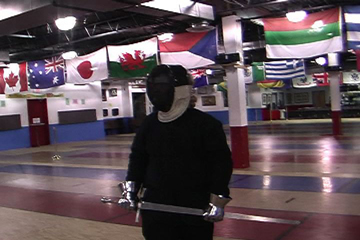
Reconstruction: Swordfighting & Frog DNA

Reconstruction: Swordfighting & Frog DNA
| About Historical Background Longsword Combat The Rise of the Rapier Misconceptions Reconstruction WMA Practice What HES Is Not Bouts Home |
Historical European
swordsmanship is intellectually satisfying because it bridges so many different
spheres – e.g., the arts of self-defense with various forms of historical
scholarship and interpretation. To give an example, in Racine, WI, at the 2005
Western Martial Arts Workshop (WMAW) – the largest annual gathering in
the U.S. of people devoted to old European fighting styles – fencing maestro Sean
Hayes, who has lately been
working on reconstructing I.33 (the sword-and-buckler manuscript mentioned earlier)
not only led a gymnasium full of students through his latest interpretation of
certain plays from that book, but later gave a Powerpoint lecture on
iconographic influences on the manuscript. Where else is art history, textual
analysis, and deadly combat integrated into a single avocation? We are lucky to have so many detailed books on late-medieval swordsmanship. However, the sources are still obscure in places, leaving much unexplained. Often, it is the fundamentals, like basics of footwork or body mechanics, that aren't made explicit, no doubt because period teachers assumed their students already knew them (having been taught how to fight and move from early childhood). This can be particularly frustrating for modern scholars and practitioners trying to reconstruct these arts, but it provides the opportunity to bring all kinds of scholarly detective work (e.g., iconographic evidence, archaeology, linguistics) to bear. As a result, reconstruction of forgotten martial arts, like reconstruction of dead languages or reconstruction of past styles of craftsmanship or cooking or music, has been likened to the cloning of dinosaurs in Jurassic Park: Because the DNA information available in fossil bones is fragmentary, complete reconstruction (cloning) required (in the book and movie) supplementation with DNA from a modern relative: frogs. Similarly, modern reconstructors of past martial arts styles have drawn on both modern (e.g. sport fencing) and cross-cultural analogies to fill in the gaps in the medieval texts. Many western martial artists in fact cross-train in Eastern and Western martial arts styles, a practice that reveals both exciting similarities and fascinating differences between cultures and methods. When practiced correctly, the 15th-century German art of the longsword, for example, looks to an untrained eye very much like the Japanese art of the katana, or samurai sword, from the same period. (The late-16th-century, lavishly-illustrated fechtbuch by Joachim Meyer shows longsword fencers in low, exaggerated stances distinctly reminiscent of Japanese brush paintings of samurai.) There are in fact some important differences between the two arts, but their superficial similarity should not be a surprise. The two weapons evolved along similar lines: Both are two-handed weapons of roughly similar length, designed for similar needs, for a directly analogous class of fighting men. Since the principles of body mechanics are fairly universal – there are certain things the human body can do and certain natural limits – such supplementation and cultural cross-fertilization is a valid procedure. But it produces wide debate, and the small community of scholars and enthusiasts engaged in the WMA project worldwide engage in quite frequently heated argument over the proper interpretation of how this or that attack or defense is to be executed. Often, it is only from actual application – applying techniques in actual swordfighting at full speed – that helps settle the dispute. Next page: Drilling and Sparring |
All material copyright 2005
Eric Wargo